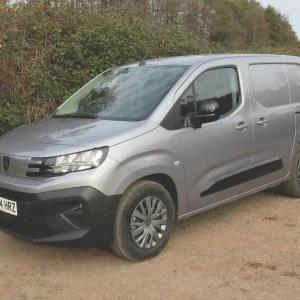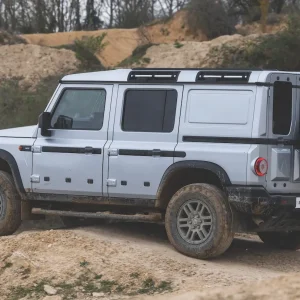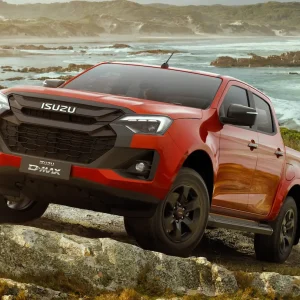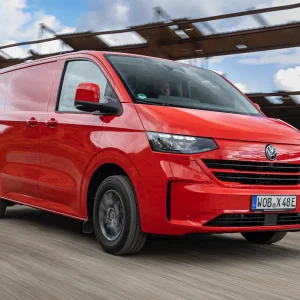Despite all the ballyhoo, brouhaha and Government grants, sales of electric vans remain sluggish. Annual registrations can be measured in their hundreds rather than thousand. And we’re talking low hundreds at that.
Operators are understandably cautious about investing in what they still view as new technology even though electric vehicles have been around almost as long as their internal combustion-powered counterparts. Aware that the range of battery-powered vans between recharges is limited, they fear they will be stranded in the middle of nowhere with a flat traction battery and a load on board that needs to be delivered urgently. And if they let a customer down, that could put their business in jeopardy.
Add to that all the issues surrounding front-end cost, battery life and residual value, and you cannot blame them for sticking with a tried and tested diesel.
Nissan is hoping to alter that perception, however, with its front wheel-drive electric e-NV200, which has just gone on sale in Britain. Using drivetrain technology borrowed from Nissan’s Leaf electric car, the manufacturer claims it allows users to enjoy major running cost savings, thanks to the low cost of the electricity required to power it – we’re talking pennies a mile – and modest maintenance bills.
To those savings can be added zero-rated Vehicle Excise Duty and exemption from the London Congestion Charge, plus the environmental kudos you get from running a zero-emission vehicle.
Nissan has launched the e-NV200 with no less than five different trim levels, which seems a little excessive, and we went for the top-of-the-range Acenta Plus.
Cab
If you want to reassure prospective customers who may still be dubious about investing in battery power then your best bet is to make the cab interior of your electric van look as conventional as possible. Wisely, that’s the approach Nissan has taken with the e-NV200. The only thing that might jar a bit is the shift lever; however, it is little different from one that might be found in an automatic van, with park, neutral, reverse, and drive settings. A starter button sits next to it and to operate it you need to have the van’s iKey intelligent key fob with you, while there’s also a green ‘Eco’ button that restricts the van’s performance, thereby extending its range by a few miles. Many diesel vans have Eco buttons these days too, of course, and for much the same reason.
Whatever its other virtues may be, the e-NV200 is not endowed with a lot of in-cab storage space, with a small bin in each door plus a lidded glove box that can barely accommodate the instruction manual. In addition, there are a couple of shelves on the dashboard and a cup-holder at each extremity.
At least you get a capacious lidded box between the front seats along with a tray, two more cup-holders, and some slots for small change for the ever-hungry car park ticket machine (just because it’s an electric van do not assume that you are automatically exempt from car park charges).
The steering column is height-adjustable, but the driver’s seat is not, and that is the case even in top-of-the range models.
Load area
Access to the cargo bay is via a sliding door on each side plus twin, asymmetric doors at the back. The narrower of the two is on the offside and both can be swung through 180º once you unlatch the easy-to-release stays.
All unglazed, the doors open to reveal a 4.2m³ load area with half-a-dozen floor-mounted load tie-down points. Unsecured loads that slide forwards during heavy braking should be stopped from slithering into the cab by the hefty-looking full-height, glazed, steel bulkhead.
A tailored rubber mat protects the load bed from minor scrapes, and sound-deadening panels on the sides and doors should provide at least some defence from scrapes and scratches, but the entire load bay will probably need timbering out before use.
Maximum load length is 2040mm. Maximum width is 1500mm narrowing to 1220mm between the wheel boxes, while maximum height is 1358mm. Maximum rear loading height is 523mm.
Gross weight is 2220kg, while gross payload capacity is 703kg. Bear in mind that the e-NV200 is not permitted to tow a trailer – a potential drawback for some firms.
Powertrain
Flip open the bonnet and you will find an 80kW AC synchronous electric motor married to a single-speed step-less transmission. Fully integrated with the battery charger and inverter, the motor draws power from a 24kWh 48-module 360V 192-cell laminated lithium-ion battery pack mounted under the load floor. The pack is positioned in a reinforced area to protect it in a collision. Giving the van a low centre of gravity, it brings the extra benefit of boosting torsional and lateral stiffness by 20% and 35% respectively compared with the standard NV200 model.
Maximum torque is 254Nm, and with an electric motor it is all instantly available.
Chassis and steering
The Nissan is fitted with electric power steering, and the turning circle is 10.6m kerb-to-kerb. Independent suspension with MacPherson struts is fitted at the front while a torsion beam axle helps support the rear.
Performance
Check that the shift lever is in ‘P’ for park, plant your foot on the brake pedal, then press the starter button and watch the instrument panel light up. You’re ready to go, so slot the lever into ‘D’ for drive, release the handbrake, and you’re away.
With all the torque an electric motor can generate instantly available, acceleration from rest is brisk and continues to be smooth as you gather speed. All the while, however, you are watching the dashboard display, not just to see how fast you are going but to see how many miles of range remain. The display also shows the level of battery charge and regeneration.
If you want to extend your range then slow down, hit the Eco button and tap the shift to the right and into the ‘B’ for braking position. That will increase the level of regenerative braking – although not to the extent that you stand the van on its nose – and ensures that energy that would otherwise be wasted is channelled into the battery pack.
As mentioned earlier, resorting to the Eco button limits your performance, but is unlikely to prove a problem unless you are heavily laden and tackling hilly terrain.
Riding and handling better than we expected it to, the e-NV200 is undoubtedly quiet. However, as a consequence of the lack of decibels, pedestrians step off the pavement in front of you and cyclists happily wobble about inches from your front bumper because they are simply not aware of your presence.
Answer? Make sure the Vehicle Sound for Pedestrians (VSP) system is on, which alerts people to your presence at around-town speeds of below 19mph (always assuming that they are not wearing headphones).
No dBs from a diesel engine means that all the other sources of noise on a vehicle are instantly heightened. In our case, that meant an intermittent rattle from the base of the bulkhead that we couldn’t eliminate, despite thumping the partition hard on several occasions.
While Nissan quotes an official figure of 106 miles for the van’s range, which might theoretically be possible in ideal conditions with an ultra-careful driver, for practical day-to-day purposes the true range we would suggest is more likely to be 70 to 80 miles. We started with 70 miles shown, clocked up 46 miles lightly laden but with the highly effective aircon on and the radio blaring out, and had 24 miles showing when we returned to base. The Eco button was depressed throughout and the shift lever was in the B position.
We plugged the van into a standard domestic three-pin electrical wall socket for 90 minutes to recharge, which doubled the potential range to 48 miles.
Cruise control is standard and might help drivers keep the speed of what is a remarkably lively vehicle down to a sensible level.
Equipment
In-cab features include an MP3/iPod-compatible radio/CD player, Bluetooth connectivity and an aux-in socket. The satnav features a touch-screen display that instantly shows the view to the rear of the vehicle courtesy of a camera when you engage reverse.
Electric windows and climate control are included in the deal, and our van came with what Nissan calls a Cold Pack for an extra £130 (all prices quoted here exclude VAT). It embraces heated front seats, a heated steering wheel and heated door mirrors which Nissan found during trials with British Gas to reduce usage of the more energy-sapping air conditioning.
Electric adjustment for the mirrors is a standard feature whether you opt for the Cold Pack or not; however, they would benefit from a lower wide-angle section.
Buying and running
Nissan offers customers a choice if they want to acquire an e-NV200: buy the entire vehicle outright or opt for Flex, an arrangement that allows you to cut the front-end price by roughly £5000 because you lease the battery pack at from £61 a month, depending on how many miles you propose to cover annually. Whichever option you choose, you still benefit from the Government’s Plug-In Van Grant, which in the e-NV200’s case cuts the purchase price by another £5000, although grants of up to £8000 are available depending on the vehicle you select.
Pulling up a flap on the van’s nose reveals two ports: one for rapid charging and one that can draw power from a domestic supply. Cables are provided for both. The battery can be recharged overnight using a domestic 16-amp single-phase 3.3kW supply, says Nissan, although the 32-amp/6.6kW supply cuts the total recharging time to four hours.
A dedicated ChaDeMo DC 50kW quick-charger can give the battery up to 80% of its charge back in 30 minutes or less, says the manufacturer, if it is already partially charged. More than 1000 public quick-chargers are now in place across Europe, but watch the variable costs of using them.
Service intervals for the e-NV200 are set at 12 months/8000 miles – it’s unlikely ever to be a high-mileage vehicle – while the warranty lasts for three years/100,000 miles.
Safety
ABS, Hill Start Assist, Electronic Stability Programme and Traction Control are all present on the vehicle, while disc brakes are fitted all around.
Front fog lights are standard, and driver and passenger airbags are fitted.
Turning to security, a button on the dashboard allows you
to lock/unlock all the doors, while the iKey includes remote central locking.
Verdict
Ideal for handling short-haul local work, the Nissan e-NV200 is by far and away the most convincing and practical electric van we’ve encountered to date.
History
What was later to become the e-NV200 first appeared as a sketch back in November 2009.
Building on technology borrowed from the Nissan Leaf, the concept vehicle first broke cover at the 2012 North American Auto Show in Detroit. By this time, prototype NV200-based electric vehicles were already on test with the Japan Post Service and with FedEx in London.
Later in 2012, Coca-Cola Central Japan started putting the e-NV200 on trial, as did British Gas. November 2013 witnessed the announcement of a six-month assessment of 28 of the vans by British Gas in partnership with Hitachi Capital Commercial Vehicle Solutions and Gateshead College, a move that resulted in the utility ordering an initial 50, while a further 50 will be delivered by the end of this year.





